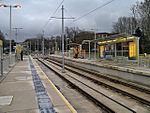Greater Manchester University Technical College
2014 establishments in EnglandDefunct University Technical CollegesDefunct schools in the Metropolitan Borough of OldhamEducational institutions disestablished in 2017Educational institutions established in 2014 ... and 2 more
University of BoltonUse British English from February 2023
The Greater Manchester University Technical College, branded as "The GM", was a University Technical College in Oldham, Greater Manchester, United Kingdom. The college specialised in sustainable and civil engineering and opened in September 2014. Owing to low pupil numbers and poor pupil attainment, the college closed less than three years later at the end of the 2016–17 academic year.
Excerpt from the Wikipedia article Greater Manchester University Technical College (License: CC BY-SA 3.0, Authors).Greater Manchester University Technical College
Rochdale Road,
Geographical coordinates (GPS) Address Phone number Website Nearby Places Show on map
Geographical coordinates (GPS)
| Latitude | Longitude |
|---|---|
| N 53.5423 ° | E -2.1214 ° |
Address
The Oldham College
Rochdale Road
OL9 6AA , Coldhurst
England, United Kingdom
Open on Google Maps








